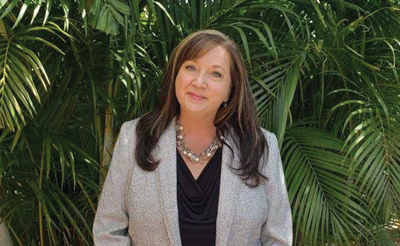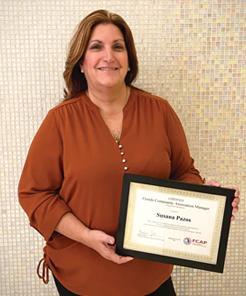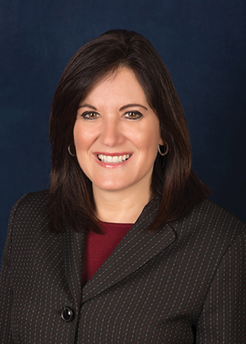
FCAP Community
Published February 2020
Florida Community Association Professionals’ (FCAP) training is offered on two levels. Level one consists of courses meeting Florida’s continuing education requirements for CAMs, and level two is the Florida Advanced CAM Studies (FACS) courses. For further information about the more than 50 online continuing education classes available or to pursue the Certified Florida Community Association Manager (CFCAM) designation, please visit www.fcapgroup.com/membership/education-training/.
Congratulations to CFCAM Susy Pazos!
By Kathy Danforth
Florida Community Association Professionals (FCAP) welcomes Susy Pazos to the distinguished roster of Certified Florida Community Association Managers (CFCAM).
Susy began her career in the hospitality field working for several hotel chains, followed by a switch to property management in 2001. “I enjoy working with people, solving problems, and developing teams. I thrive on making people feel at home and comfortable and decided the best place to make people feel at home would be in their own home,” she says.
Susy has served in various roles with FirstService Residential for her property management career, including as corporate trainer. For the last eight years, she has been community association manager for Mosaic on Miami Beach Condominium Association.
Susy shares, “The most rewarding part of the job is being in the community and feeling like a part of a family with both the employees and the residents. Being able to see residents’ families grow up and expand and watching life milestones take place gives me such a sense of gratitude. Seeing employees flourish and be promoted and feeling that my mentoring has inspired them with their career growth and goals makes me feel like a good mother.”
Along the way Susy has benefited from the impact of others. She credits Hector Vargas and Edwin Lugo, president and vice president of FirstService Residential High-rise Division, with having the most impact on her career. “They both have great leadership skills and share a willingness to give,” notes Susy. “They have a gift for recognizing fresh talent and providing them with vision, opportunities, and tools to grow. I’ve had the privilege to work with many people throughout the years who have helped me grow as a professional.”
Susy states, “The biggest challenge in my job is trying to anticipate all residents’ needs and exceed expectations while following rules and budgetary constraints.” Striking this balance between controlling costs and maintaining the expected lifestyle is one of the main issues for managers, according to Susy. Managers are also faced with “keeping up with the changes in technology, security systems, and software procedures to remain safe and secure.”
This need to stay abreast of changes in many areas attracted Susy to seek her CFCAM designation. “Understanding new technologies, learning about different aspects of property management, and being prepared for legal changes are critical for CAMs and led me to want to continue my development and knowledge,” she says.
Susy is proud of being named by peers as a Top 10 Finalist for Manager of the Year in 2014. She adds the CFCAM certification, for which we congratulate her.
Because You Asked
By Betsy Barbieux, CAM, CFCAM, CMCA
Betsy,
I have a quick question. Are emails between board of director members where more than three members are included in the email considered a quorum for a board of five?
– Ginger
Ginger,
The statutes for all community associations allow email conversation among board members. However, they have never been able to vote via email, which the statutes have reaffirmed.
Emails that include management are considered official records and could be discoverable. Currently, private email accounts of board members are not considered official records or discoverable.
– Betsy
Betsy,
Are annual audits required for HOAs? If the association’s revenues are below $500,000, is an audit not required even if the documents state the association must have an annual audit?
– Jonathan
Jonathan,
Whether or not any community association does an audit is based on revenue—greater than $500,000.
This statute looks like it supersedes the documents—Section 720.303
(7) FINANCIAL REPORTING.— Within 90 days after the end of the fiscal year, or annually on the date provided in the bylaws, the association shall prepare and complete, or contract with a third party for the preparation and completion of, a financial report for the preceding fiscal year. Within 21 days after the final financial report is completed by the association or received from the third party, but not later than 120 days after the end of the fiscal year or other date as provided in the bylaws, the association shall, within the time limits set forth in subsection (5), provide each member with a copy of the annual financial report or a written notice that a copy of the financial report is available upon request at no charge to the member. Financial reports shall be prepared as follows:
(a) An association that meets the criteria of this paragraph shall prepare or cause to be prepared a complete set of financial statements in accordance with generally accepted accounting principles as adopted by the Board of Accountancy. The financial statements shall be based upon the association’s total annual revenues, as follows:
- An association with total annual revenues of $150,000 or more, but less than $300,000, shall prepare compiled financial statements.
- An association with total annual revenues of at least $300,000, but less than $500,000, shall prepare reviewed financial statements.
- An association with total annual revenues of $500,000 or more shall prepare audited financial statements.
(b) 1. An association with total annual revenues of less than $150,000 shall prepare a report of cash receipts and expenditures.
2. A report of cash receipts and disbursement must disclose the amount of receipts by accounts and receipt classifications and the amount of expenses by accounts and expense classifications, including, but not limited to, the following, as applicable: costs for security, professional, and management fees and expenses; taxes; costs for recreation facilities; expenses for refuse collection and utility services; expenses for lawn care; costs for building maintenance and repair; insurance costs; administration and salary expenses; and reserves if maintained by the association.
You might check with your attorney for a correct interpretation!
– Betsy
Betsy,
I have a question with regards to our HOA. Can the board of directors extend their term in office if they don’t hold an election as prescribed in the bylaws? What can the homeowners do in this case?
– Gene
Gene,
Following the language in Chapter 617, The Florida Not for Profit Corporate Act, most documents say that the board members serve until their successors are elected or appointed.
Assuming an annual meeting was scheduled and proper notices and agendas were mailed or delivered to owners 14 days ahead of time, or as otherwise prescribed by the bylaws, and the quorum was not met and there were no candidates for the board, the current board members just “rollover” to the next year because their “successors have not been elected.”
If any of those board members want off the board, they would wait until after the annual meeting is adjourned (where there was no election) and resign at the board’s organizational meeting. The remaining board members can then appoint someone to fill that seat. Then at the organizational meeting the board members would choose their officers.
– Betsy
Betsy,
We are a small 32-unit condominium and are having trouble with people coming in at nighttime to ransack our vehicles and steal anything not nailed down. I received three quotes for gates, and the lowest quote was about $21,000 to install two gates with the automation to go along with it. I am trying to fund it in-house. Can we borrow money from our emergency fund and repay it? Or would it be better to get a loan?
– Larry
Larry,
That is unfortunate your community is experiencing such vandalism and theft. What a shame.
Who created the “emergency fund”? Was it a membership vote, or did a previous board of directors set it up? When the board or owners decided to create this fund, do you have in the minutes the definition of “emergency”? It doesn’t look like you are using any type of formula to add money to these funds. So, to me, assuming a previous board of directors created the account, your “emergency fund” looks like “contingency” and could be spent on anything.
I would suggest you take the “emergency fund” line item off your reserve schedule. It is not a proper reserve. Consider putting those monies in a separate bank account that offers interest, and it will then show up on your balance sheet as an asset. You can still add to the fund periodically, but it’s technically not a reserve.
– Betsy
CAM to CAM
Exterior Renovations, and Upgrades, Part I
Marcy L. Kravit, CMCA, AMS, PCAM, CFCAM
Florida Community Association Professionals (FCAP) Education and Training Coordinator
AKAM On-Site Managing Director
Editor’s Note: This is the first of a two-part article that deals with exterior renovations, restorations, and upgrades.
Does your community have curb appeal? A large percentage of prospective buyers decide whether to seriously look inside a home or condominium unit based on its curb appeal—that is, the view they see when they drive by or arrive for a showing.
As managers, it is our responsibility to make sure prospective buyers are attracted to the property and property values are at competitive levels. It is our job to strategically plan and spend sufficient time working on improving the property’s exterior appearance, aesthetics, common areas, and building structure.
Board members are concerned about protecting and improving property values. Renovating and upgrading building structures, systems, and common areas can achieve this. The board has the ultimate responsibility to set the standards and establish financial requirements needed to see that the standards are met.
Excessive traffic, wear and tear, and aging contribute to a community’s needs for renovations and restoration. The health and aesthetic standards of the community need to be met. Exterior renovations and restoration can be described as the replacement and/or the refurbishment of a building’s “major” components, common areas, or building structure and systems. Examples of items to consider are listed below.
Asphalt replacement and seal coating and striping—Over time, mineral deposits, the sun, oil, and grease contribute to the need to replace the asphalt. Seal coating and striping will improve the appearance.
Awnings—Awnings are decorative and add shaded protection. The two types to be considered are UV-protected fabric (vinyl or polyester canvas), which prevents sun damage, keeps temperatures cool, and stays waterproofed, or 12- to 18-oz. multilayered or multithread awning material. Make sure they are fade resistant and fire retardant.
Balcony restoration/painting—Over time, every building will have to be evaluated for this type of work, especially waterfront properties exposed to salt air. Rest-oration of an old structure requires many different forms of cleaning, restoring, rebar replacement, sealing, and painting in order to protect and restore the structure.
Dock and seawall repairs/replacement—It is important to address boat docks and seawalls for repairs. Loose deck boards, rotting frames, and holes in the seawall can cause safety issues.
Exterior door replacement or installation of automatic doors—Replacing exterior doors can add immeasurably to a condominium association’s appearance and contribute to the ease of accessing the entranceway. A new front entry door can add style and convenience to an otherwise unimposing façade. In addition to improving the look of a condominium, new doors can add value, security, and comfort.
Fences & gate systems—A fence/gate system’s contractor can assist the board of directors in making the right choice in material and design that enhances the look of the community, fits in with the neighborhood, and provides additional security.
HVAC/cooling tower replacement—For a new cooling system, a quality contractor will perform an evaluation and explain in detail the extent and types of changes needed in the system for increased efficiency. Once the system is installed, you can expect your contractor to explain daily and periodic maintenance as well as describe what you need to do to maximize the system’s performance and maintain its warranty.
Landscaping upgrades—Working with a landscape architect can help you create an outside environment that provides valuable curb appeal. In addition to design services, landscape architects can help analyze and prepare a site plan that is functional, aesthetic, and environmentally attuned to the property. The landscape architect can also assist with the recommendation of upgrading irrigation systems.
Outdoor landscape lighting and fixture replacement—Decorative outdoor lighting will make your community much warmer and more inviting. Garden accents become focal points. Illumination is the last thing potential intruders want to encounter. So, at the same time as you beautify the community with upgraded outdoor LED lighting, you increase safety and security.
Parking garage repairs and renovations—Develop a comprehensive approach to solving the problem of water penetration. Concrete structures may become victims of serious structural deterioration if not protected.
Paver installation—Pavers can add elegance to your community. The look can be formal or informal but can evoke a sense of timeless sophistication.
Planter waterproofing—Although the added beauty of planters can significantly improve the aesthetics and general ambiance of a community, they can cause potential damage if not properly waterproofed. Planter leaks are often responsible for the delaminating of surrounding deck coatings and dry-rot, as well as damage to any area below or adjacent to the planters.
Pool and beach furniture purchases— Improper care and maintenance will reduce the longevity of outdoor pool furniture. The most damaging materials are suntan oils, human perspiration, and environmental pollutants. Purchasing new pool furniture is a significant investment and will add to the appearance of the community’s pool area.
Pool and spa upgrades— Even well-maintained swimming pools eventually need repair and code and safety upgrades. Chipped tile, marcite wear, cement cracks, leaks, depth markers, and pump and equipment malfunctions are all common problems that may need to be addressed.
Railing replacement—Railing configurations can complement the building’s design, from curved tempered glass to standard pre-assembled railings. Custom railings can be as varied as your imagination.
Refurbish tennis/basketball courts—Determining the condition of the asphalt or concrete tennis/ basketball court is very important. Refurbishing the surface could improve player comfort and court playability. Tracks and depressions can be treated.
Roof replacement—It is a big investment. Interview and hire the right roofing contractor for your project. You may wish to consider hiring an engineer or roofing consultant to provide a set of specifications and an evaluation. Plan ahead. Due to the number of hurricanes, several issues are making roofing projects more difficult, including the demand for roofing contractors and a shortage of supplies.
Tiki hut thatching repairs—Thatching tiki huts with new, innovative products and adding new supports provides durability, waterproofing, and solar protection. Over time bamboo wears out and the huts lose their fronds.
Window replacement—There are significant advantages to replacing old, single-pane windows. Installation saves substantially on energy costs, prevents leaks, and adds to the value of the building. The poorer the performance of the current windows, the more noticeable the energy savings will be. Older, drafty single-pane windows and sliding glass doors may lose as much as 50 percent more energy in heat or AC loss than new double- or triple-pane windows. The savings depend on the condition of the existing windows and the type of replacement windows.
Women in the Industry
Editor’s Note: The contact information for Denine Barham in the November issue of FLCAJ was incorrect. Her Women in the Industry biography is reprinted here with the correct contact information.
 Denine Barham
Denine Barham
Senior Vice President/Relationship Market Manager
BB&T now Truist
5830 142nd Avenue N.
Clearwater, FL 33760
(727) 373-1910
DMBarham@bbandt.com
www.bbt.com
Denine Barham has been with BB&T Association Services for nine years and has served as Senior Vice President and Relationship Market Manager for the past four years. Denine began her banking career at Michigan National Bank, relocating in 1989 to join the fast-paced and expanding financial services industry in Florida. Prior to joining BB&T, Denine served in a variety of banking leadership roles including branch operations, branch management, small business banking, and training and development. Her wide-ranging experiences have afforded her the knowledge and get-it-done attitude necessary in today’s ever-changing community association industry. With BB&T Association Services, Denine and her sales team cover 15 states and the District of Columbia. Her team of experienced professionals is a strong resource for property management companies and self-managed associations—providing valued advice on a full range of financial options, including association loans, deposits, investments, payment processing, and FDIC coverage. Her focus is always on the client and preforming at the highest level of professionalism and ethical behavior.






